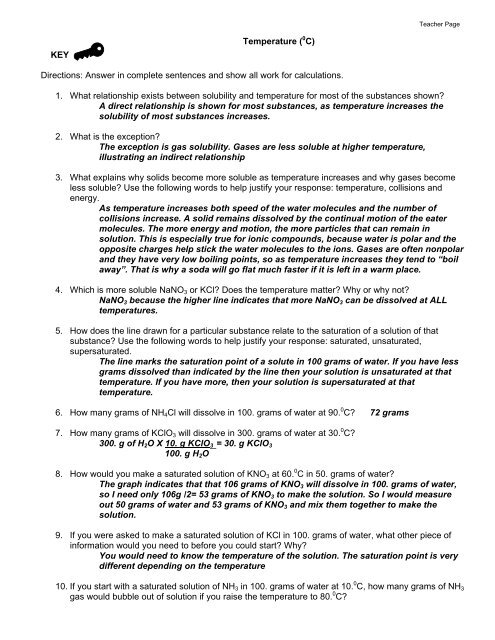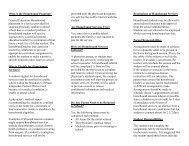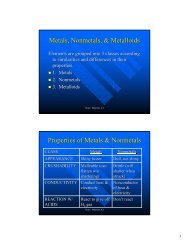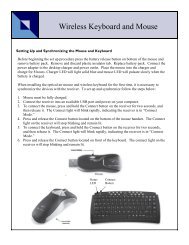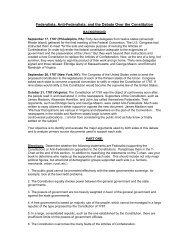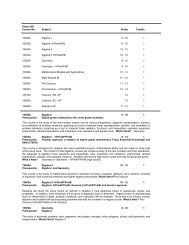Solubility Practice a Curvy Subject
Solubility Practice a Curvy Subject
Solubility Practice a Curvy Subject
Create successful ePaper yourself
Turn your PDF publications into a flip-book with our unique Google optimized e-Paper software.
Teacher Page<br />
KEY<br />
Temperature ( 0 C)<br />
Directions: Answer in complete sentences and show all work for calculations.<br />
1. What relationship exists between solubility and temperature for most of the substances shown?<br />
A direct relationship is shown for most substances, as temperature increases the<br />
solubility of most substances increases.<br />
2. What is the exception?<br />
The exception is gas solubility. Gases are less soluble at higher temperature,<br />
illustrating an indirect relationship<br />
3. What explains why solids become more soluble as temperature increases and why gases become<br />
less soluble? Use the following words to help justify your response: temperature, collisions and<br />
energy.<br />
As temperature increases both speed of the water molecules and the number of<br />
collisions increase. A solid remains dissolved by the continual motion of the eater<br />
molecules. The more energy and motion, the more particles that can remain in<br />
solution. This is especially true for ionic compounds, because water is polar and the<br />
opposite charges help stick the water molecules to the ions. Gases are often nonpolar<br />
and they have very low boiling points, so as temperature increases they tend to “boil<br />
away”. That is why a soda will go flat much faster if it is left in a warm place.<br />
4. Which is more soluble NaNO 3 or KCl? Does the temperature matter? Why or why not?<br />
NaNO 3 because the higher line indicates that more NaNO 3 can be dissolved at ALL<br />
temperatures.<br />
5. How does the line drawn for a particular substance relate to the saturation of a solution of that<br />
substance? Use the following words to help justify your response: saturated, unsaturated,<br />
supersaturated.<br />
The line marks the saturation point of a solute in 100 grams of water. If you have less<br />
grams dissolved than indicated by the line then your solution is unsaturated at that<br />
temperature. If you have more, then your solution is supersaturated at that<br />
temperature.<br />
6. How many grams of NH 4 Cl will dissolve in 100. grams of water at 90. 0 C? 72 grams<br />
7. How many grams of KClO 3 will dissolve in 300. grams of water at 30. 0 C?<br />
300. g of H 2 O X 10. g KClO 3 = 30. g KClO 3<br />
100. g H 2 O<br />
8. How would you make a saturated solution of KNO 3 at 60. 0 C in 50. grams of water?<br />
The graph indicates that that 106 grams of KNO 3 will dissolve in 100. grams of water,<br />
so I need only 106g /2= 53 grams of KNO 3 to make the solution. So I would measure<br />
out 50 grams of water and 53 grams of KNO 3 and mix them together to make the<br />
solution.<br />
9. If you were asked to make a saturated solution of KCl in 100. grams of water, what other piece of<br />
information would you need to before you could start? Why?<br />
You would need to know the temperature of the solution. The saturation point is very<br />
different depending on the temperature<br />
10. If you start with a saturated solution of NH 3 in 100. grams of water at 10. 0 C, how many grams of NH 3<br />
gas would bubble out of solution if you raise the temperature to 80. 0 C?


